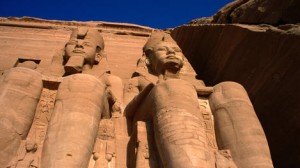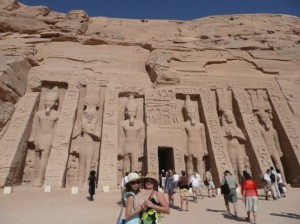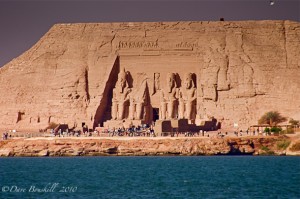Abu Simbel is an archaeological site comprising two massive rock temple in southern Egypt vacation, Egypt packages, Egypt vacations packages on the west bank of Lake Nasser about 290 km southwest of Aswan. It is part of UNESCO World Heritage Site known as the “Nubian Monuments”, which begins from the direction of flow of the river from Abu Simbel to Philae (near Aswan).
Twin temples were originally carved from the mountains in the reign of King Ramses II in the 13th century BC, a lasting monument to him and to Queen Nefertari, to commemorate his victory at the Battle of Kadesh. However, in 1960 was moved to College Park facilities  elsewhere, the artificial hill made of the structure of the dome, above the reservoir and the High Dam at Aswan.
elsewhere, the artificial hill made of the structure of the dome, above the reservoir and the High Dam at Aswan.
It was necessary to transfer the temples to avoid being drowned through the creation of Lake Nasser, and a massive artificial water reservoir after the construction of the Aswan High Dam on the River Nile. Abu Simbel and still one of the best areas to attract Egypt students tours, Egypt budget tours
.
To build The construction of the temple complex at about 1244 BC and lasted for almost 21 years, until 1265 BC. Known as the “Temple of Ramses,” beloved by Amun “, and it’s one of six rock temples in Nubia, which took place during the reign of Ramses II. Their purpose is to impact the effect of neighboring countries in southern Egypt, and also to reinforce the status of Egyptian religion in the region. Historians say that the design of Abu Simbel expresses something of the pride of Ramses II. differ Abu Simbel described in this page from Abu Simbel displacement, which is an extension of Abu Simbel tourist, but it lies about 366 kilometers south of Aswan
Rediscover the
Over time, abandoned temples, then your are covered with sand. At the time, during the 6th century BC, the sand covering the statues of the main temple up to the knees. The temple was forgotten until 1813, when Swiss orientalist found GL Borjardt on the Corniche in the main temple. He spoke Borjardt for this discovery with his Italian explorer Giovanni Balonza, who traveled together to the site, but they could not dig the entrance of the temple. Balonza and returned in 1817, but this time succeeded in his attempt to enter the compound. And taking all the values that can be carried with him. Tour guides on the site link the myth of the “Abu Simbel”, it was a small local boy who led the explorers to the site again in the early of the buried temple which he saw from time to time in the quicksand. At the end of the day, fired on the name of Abu Simbel temple according to his name.
Took great building of the temple of Abu Simbel in almost twenty years, was completed in about 24 years of the reign of Ramses the Great (which is equivalent to 1265 BC). Was dedicated to the god Amun, patron – Harakhca, Ptah, as well as Ramses. And is generally considered the finest and most beautiful temples commissioned during the reign of Ramses II, and one of the most beautiful in Egypt.
Four giant statues of the Pharaoh, which reaches a length of 20 m with a crown Atef double Ugean marine and tribal to decorate the front of the temple, which is currently 35 meters, and crowned by cornice which 22 baboon, flanked the entrance worshipers of the sun. The huge statues carved directly from the rocks in were located in the temple before transfer. All statues represent Ramses II seated on a throne and wearing the double crown  of the sea and tribal Ugean to Egypt. The statue which is located on the left of the entrance were damaged in the earthquake, leaving intact only the lower part of the statue. It can be seen the head and the trunk under the feet of the statue. Next to the legs of the statue of the huge, there are other statues of not more than the rise for the knees of the pharaoh. This shows Nefertari wife Home of Ramses, and Queen Mother Mutay, and has two sons Amun cat Khbashv, Ramses, and has six daughters Bntanat, Bactmot, Nefertari, Mritamn, Neptawi, and Ostnovrt.
of the sea and tribal Ugean to Egypt. The statue which is located on the left of the entrance were damaged in the earthquake, leaving intact only the lower part of the statue. It can be seen the head and the trunk under the feet of the statue. Next to the legs of the statue of the huge, there are other statues of not more than the rise for the knees of the pharaoh. This shows Nefertari wife Home of Ramses, and Queen Mother Mutay, and has two sons Amun cat Khbashv, Ramses, and has six daughters Bntanat, Bactmot, Nefertari, Mritamn, Neptawi, and Ostnovrt.
The entrance itself Crested carved bas, representing two of the king is worshiped falcon with the head shepherd Harakhca which stands her statue in the niche large. This god holds in his right hand held hieroglyph user and badminton, while holding in his left hand Mat goddess of truth and justice, and this at least a plant of the cryptogram giant Ramses II
And the throne name Maat user – irrigation. On top of the building’s facade crowned with a row of 22 baboons monkey and raised their arms in the air, and are supposed to worship the rising sun. And features of other leading interface of the building are the panel recorded the marriage of Ramses to the daughter of King Hatseli the third, which led to peace between Egypt and Hettits. The inner part of the temple has the same design trio followed by most of the temples of ancient Egyptian, with a decrease in size of the rooms from the entrance to the temple. The temple is a very complex structure and unusual because of the many side rooms. Alhipstyl the hall (and sometimes called Prunaos) is a 18 m length and width of 16.7 meters and is supported by eight columns huge Oserad depicts Ramses Challenger is associated with the god Osiris, the god of hell, and refers to the eternal nature of the Pharaoh. Huge statues along the wall on the left side, and bear the white crown of the tribal face, while on the opposite side who wear the double crown of the sea Ugean, tribal and on the lower part of the walls stand out Prunaos pictures of scenes from the battles waged by the ruling military campaigns. The statue is of the Battle of Kadesh on the Orontes River, called in this day Syria, which fought against the king of Egypt, King Hetes
And embossing the most famous king is shown on the bandwagon darts called darts against fleeing enemies who Aakhazu prisoners. And other scenes show victories Egyptian in Libya and Nubia. Hall Alhipstyl get into the hall, the second pillar, which has four pillars decorated with scenes of beautiful offerings to the gods. There are pictures of Ramses and Nefertari with the sacred boat of Amun devout – Harakhca. Give this room to get to the lobby of a browser in the center and it is the entrance of the temple. Here, the black wall, there are pieces of sculptures of rock to the four statues of seated: Ra – Horakhca, Ramses King deified, and the gods Amun Ra and Ptah Ra Horjarta, Amun Ra and Ptah were main gods in that period, and the centers of the community in Heliopolis, and Thebes, and Memphis, respectively . and the axis of the temple put in place by the Engineer of the ancient Egyptian way that twice a year on October 21 and 21 February, the  sun beats the temple and cast light on the statue appears on the back wall, except the statue of Ptah, the god was linked to hell, which has always been in the dark. It is said that these dates are suitable rejoicing the birth of the king and a row on his coronation, but there is no evidence to support this, although it is quite logical to assume that some of these appointments related to a major event, such as the celebration of Jubilee thirtieth anniversary of the reign of Pharaoh. In fact, according to calculations made on the basis of the solar altitude for the star Sirius (Sothis) and inscriptions has been found, archaeologists, history should have been October 22. This image of the king has been strengthened and revitalization of the solar star, and the deified Ramesses the Great could take his place next to Amun Ra devout – Horakhca.
sun beats the temple and cast light on the statue appears on the back wall, except the statue of Ptah, the god was linked to hell, which has always been in the dark. It is said that these dates are suitable rejoicing the birth of the king and a row on his coronation, but there is no evidence to support this, although it is quite logical to assume that some of these appointments related to a major event, such as the celebration of Jubilee thirtieth anniversary of the reign of Pharaoh. In fact, according to calculations made on the basis of the solar altitude for the star Sirius (Sothis) and inscriptions has been found, archaeologists, history should have been October 22. This image of the king has been strengthened and revitalization of the solar star, and the deified Ramesses the Great could take his place next to Amun Ra devout – Horakhca.

